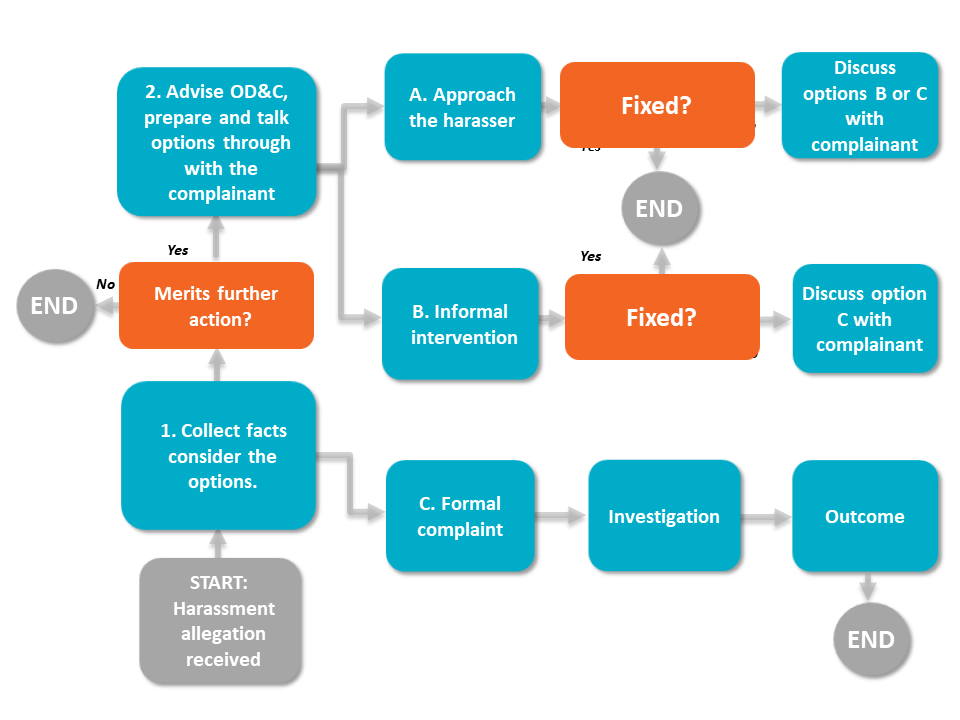How to deal with harassment, sexual harassment and bullying

Harassment, including sexual harassment and bullying are fundamental breaches of the rights all team members, contractors, clients and visitors have in our workplace. In serious cases they are grounds for dismissal. As a manager you share our responsibility for ensuring the workplace is free from these behaviours and you need to understand our policy and process for handling such allegations and be ready to act promptly. Typically, your involvement will begin with a complaint made to you either by the alleged victim or by somebody who has witnessed the behaviour.
1. Where you receive such information your first step must be to conduct a brief preliminary investigation to ascertain whether there is substance to the allegations. This typically involves getting a statement from the alleged victim, copies of any email or other documents complained of and talking briefly to any potential witnesses. You must ensure that all discussions are held in confidence (with a support person present, if appropriate), with the complainant.
Your decision. Will you conclude that on the balance of probabilities (what is most likely to have happened) there is behaviour which has breached the definitions of harassment, sexual harassment or bullying then further action is required. Your first step should be to contact Organisational Development and Capability and brief them fully before discussing the options.
2. Having discussed the matter with Organisational Development and Capability you would typically sit down with the complainant confirm that you believe their allegations merit further action and agree with them one of three typical approaches. Option A, the complainant approaches the alleged harasser/bully and attempts to resolve the situation. Option B, you (or a senior manager or Organisational Development and Capability representative) the complainant and the alleged harasser/bully attempt to reach a mediated solution. Option C, a formal written complaint is made and the company appoints an investigator to comprehensively examine the situation, reach conclusions about the allegations and recommend how resolution should be achieved.
Option A. The complainant would prepare and have a private meeting with the alleged harasser/bully. They might choose to have a support person present. The complainant would outline their complaint in the context of council’s rules and definitions of harassment/bullying and spell out clearly the impact of the behaviour on them and what they require for the future.
Option B. Informal mediation. You (or a senior manager or Organisational Development and Capability team member) would facilitate a meeting between the complainant and the alleged harasser/bully. You would ensure the complainant’s allegations were fully discussed and make clear (without necessarily taking sides) what our expectations are in terms of behaviour, what the definitions of bullying/harassment are and what the consequences of such behaviours are. You would ensure both parties listened respectfully to the other’s point of view and try to get agreement that resolves both the original complaint and any other issues that arise during your mediation efforts. Mediation can bring the matters out in a safe yet confidential environment and assist the parties to understand the nature and impact of harassing behaviours. It can also assist and facilitate the on-going working relationship between parties. If the complainant is satisfied with the outcome, the matter will be deemed to be resolved. Mediation may not be appropriate in all situations and should be carefully weighed up by all parties.
Where mediation is unsuccessful either Rotorua Lakes Council or the complainant may decide to proceed with Option C, a Formal Complaint.
An individual can make a formal complaint to the company. A formal complaint should be put in writing outlining specific details of the complaint and given either to you as their manager or Organisational Development and Capability . Organisational Development and Capability must be informed of all formal complaints.
We will appoint an investigator who will conduct a preliminary inquiry. Investigation needs to be thorough, impartial, confidential and balanced. The investigation may raise issues of criminality or misconduct/serious misconduct. Keep the complainant informed. Investigation involves talking with person complained of and anyone else who can help the investigation process. At any time the complainant can seek to have the matter referred to mediation (Option B) . If mediation is unsuccessful the complainant can return to investigation or drop the matter. Following this inquiry, the investigator will determine whether the formal disciplinary action is to be invoked and a disciplinary investigation carried out. The complainant will be given the opportunity to comment on the preliminary investigation and the decision to invoke that investigation process. throughout the investigation process it is important that accurate records are kept and that the confidentiality of all people involved is maintained.
If as a result of the investigation process a complaint is substantiated, management will take appropriate steps to ensure that:
- Suitable disciplinary action is taken against the offender
- Suitable support is available to the complainant.
- The harassment/bullying is not repeated
- Suitable education/training is provided to the offender
- If as a result of the investigation process the harassment is deemed to constitute serious misconduct, the offender may be dismissed.
- Refer to the disciplinary action process for further information.
If the matter is resolved then you should discuss with the complainant whether they wish to continue with their complaint and discuss which of options B or C are the most appropriate next step.